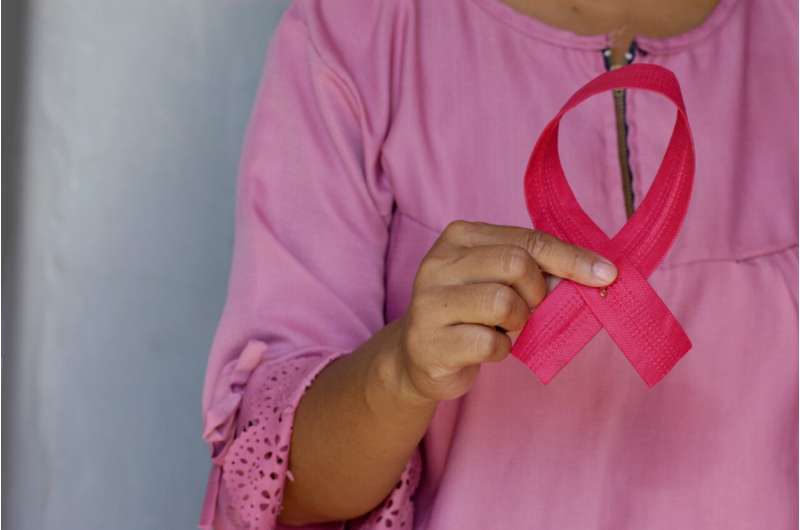This article has been reviewed according to Science X's editorial process and policies. Editors have highlighted the following attributes while ensuring the content's credibility:
fact-checked
peer-reviewed publication
proofread
Increased risk of death from breast cancer in women if treatment interval guidelines are not followed: Study

The risk of death from breast cancer is 43% higher for women who had at least one treatment interval longer than the recommended treatment timeframes, according to new research.
The research, published in the Medical Journal of Australia, examined associations between breast cancer survival and timeliness of treatment.
It found that breast cancer-specific survival was poorer for women with breast cancer who received treatment outside the recommended treatment interval timeframes, which are defined by the 2020 Australian guidelines for the treatment for early breast cancer.
Breast cancer is the second most frequent cause of cancer-related deaths of Australian women, Dr. Kou Kou said, who was the lead author of the study and is the Senior Research Officer of Epidemiology at Cancer Council Queensland.
"Despite recent efforts to improve therapy, between 33% [and] 52% of women diagnosed with breast cancer do not receive timely treatment," Dr. Kou Kou said.
"Our study shows that any delay in commencing or continuing treatment is associated with poorer survival."
The guidelines for the treatment of early breast cancer list six treatment intervals:
- diagnosis to neoadjuvant therapy (neoadjuvant systemic therapy should start as soon as diagnosis and staging is complete, ideally within two to four weeks);
- neoadjuvant therapy to surgery (surgery should be performed within four to six weeks of neoadjuvant systemic therapy, allowing for recovery from myelosuppression);
- diagnosis to surgery (surgery should be performed within one month of decision to treat with surgery for women who do not receive neoadjuvant therapy);
- surgery to chemotherapy (adjuvant chemotherapy should commence within four to six weeks of surgery);
- surgery to radiotherapy (women who have completed definitive surgery for breast cancer should commence radiotherapy as soon as possible after wound healing, and within eight weeks of surgery if no adjuvant chemotherapy received); and
- chemotherapy to radiotherapy (women who have completed definitive surgery for breast cancer should commence radiotherapy within three to four weeks of completing adjuvant chemotherapy).
The researchers at Cancer Council Queensland conducted a population-based cohort study of women aged 20–79 years diagnosed with invasive breast cancer between 1 March 2010 and 30 June 2013, as recorded on the Queensland Cancer Register.
"We compared treatment intervals for each participating woman with the guidelines," Professor Peter Baade said, a biostatistician and senior manager of descriptive epidemiology at Cancer Council Queensland.
"We found the risk of death from breast cancer was significantly greater for women who underwent surgery more than 29 days after diagnosis, or commenced chemotherapy more than 36 days after surgery, or commenced radiotherapy more than 31 days after completing adjuvant chemotherapy, compared to women who received treatment before the corresponding time points.
"The risk of death from breast cancer is 43% higher for women who had at least one treatment interval longer than the recommended timeframe."
There are several reasons why women may have longer than recommended treatment intervals, the researchers said.
"A patient's treatment intervals may be affected by a number of factors, including if they live in regional or remote Australia," Dr. Kou Kou said.
"Women using public screening facilities tend to have longer intervals compared to those using private ones. And timing matters too; starting or completing treatment in December to January often leads to longer intervals between treatments.
"Women without a family history of ovarian or breast cancer often have longer treatment intervals compared to those with a family history.
Smoking, lower household income, and not having private health insurance were linked to longer intervals."
"Therefore, it is vital that the 2020 Australian guidelines for the treatment for early breast cancer are followed as closely as possible.
"The clinical evidence is in: these guidelines save lives, so we need to make sure they are being followed by clinicians to give their patients the best chance of survival."
More information: Kou Kou et al, Treatment intervals and survival for women diagnosed with early breast cancer in Queensland: the Breast Cancer Outcomes Study, a population‐based cohort study, Medical Journal of Australia (2023). DOI: 10.5694/mja2.52091




















